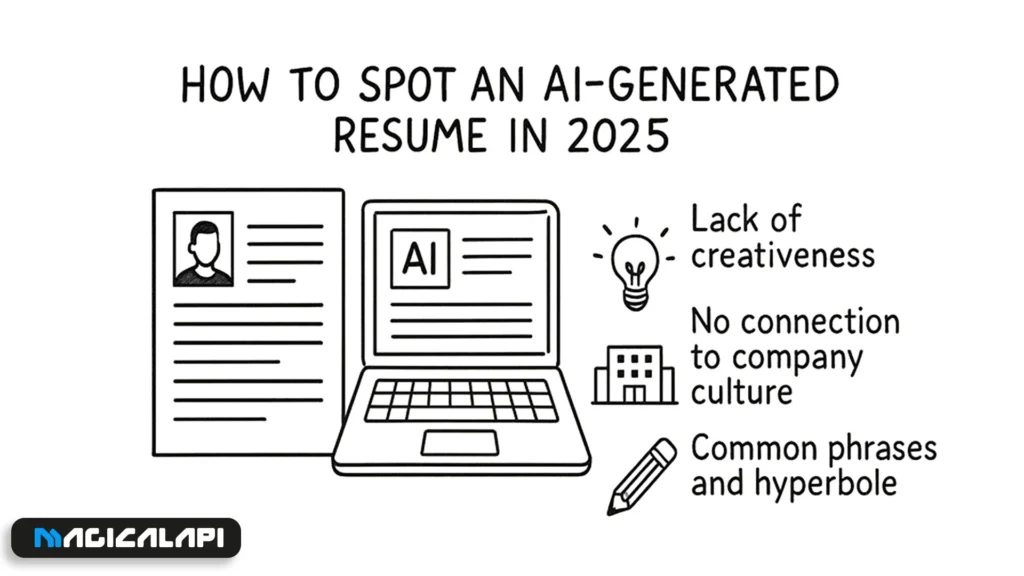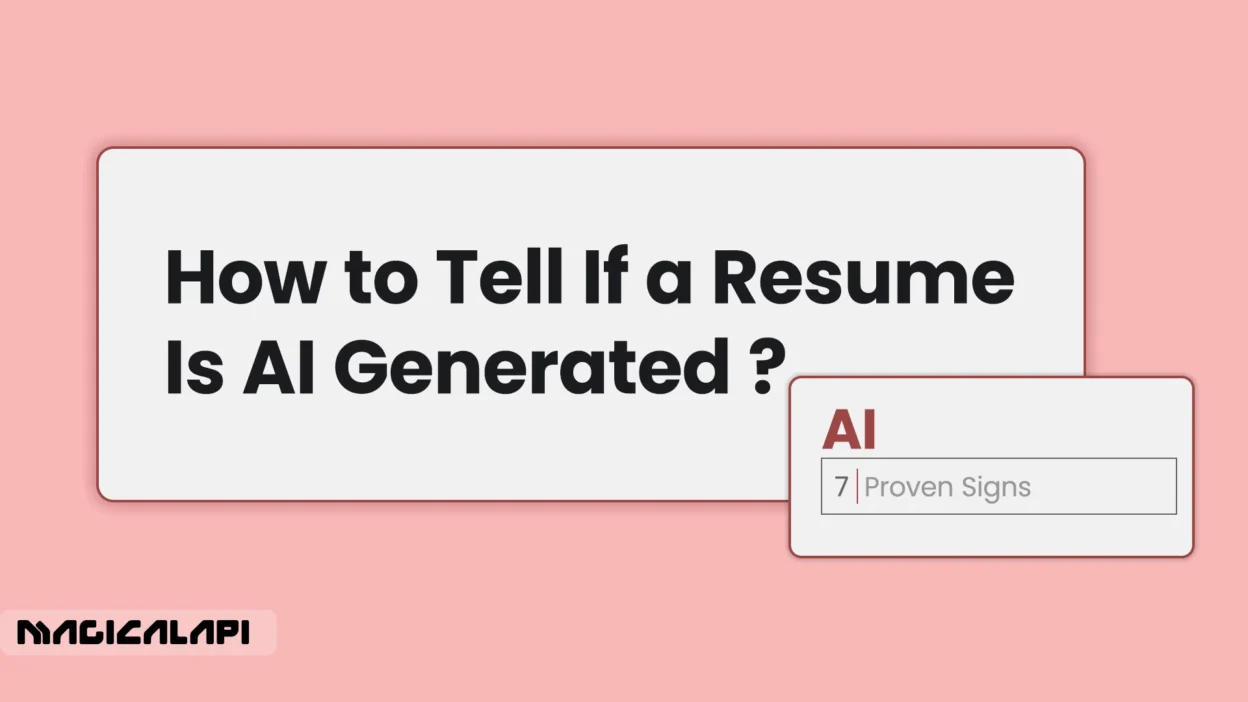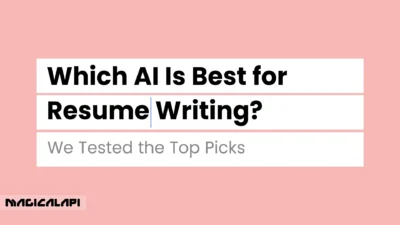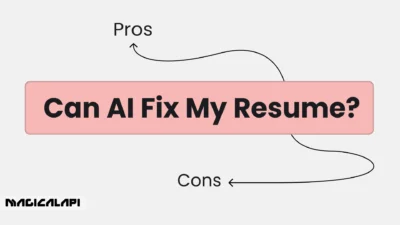Everyone is looking for an advantage in the modern job market. It’s not surprising that artificial intelligence has taken the lead, providing support to job seekers via AI resumes. Online AI resume builders promise to provide great-looking, professional-looking resumes within minutes. However, as a hiring manager or recruiter, this leaves you with yet another stopping point: how to tell if a resume is ai generated? AI is a great tool, but it is important when hiring to recognize the differences between candidates who are using AI as an advantage vs. applicants who are simply using AI and misrepresenting their skills and experience.
This guide will highlight seven reputable indicators of an AI-written resume and help you make positive hiring decisions.
Table of Contents
1. The Double-Edged Sword: When AI Helps and When It Hinders
Before we discuss the signs, we must also note that there is nothing wrong with using AI tools in the resume creation process. Many candidates will find this to be helpful. AI tools will allow someone with writing, grammar, and formatting issues to create a clean, professional-looking one-page document. They can also help any non-English speaking individuals make an accurate resume, which, although there may be language errors, is still a far cry from a non-AI-enabled resume. Many job seekers are learning how to use AI to write a resume.
The issue arises when AI is used as a crutch for the resume, and the resume is completely AI-generated. A resume generated completely by AI would most probably lack the personality and authenticity you, as the hiring manager, are looking for and the human connection with the candidate. There is a likely disconnect between the candidate’s actual skills and what is seen on paper.
The question is not, was the resume created by AI, it is to what extent was the resume created by AI. Is the resume an actual portrayal of the candidate’s skills and experience, or is it an untargeted resume or generic resume created by a machine? This is where understanding the nuances of AI Resume Optimization: Revolution or Risk? will be helpful.
1.Repetitive Phrases That Sound Too Polished
The first characteristic of an AI resume is the presence of repetitive and overly polished phrases. This is because AI training is based on large quantities of data to develop its language models —including generic resume templates and examples— so it proceeds to consistently reproduce cliched phrasing or terms you have likely seen a thousand times.
When considering catchphrases such as “results-oriented professional”, “highly motivated team player” or “proven track record of success”, each of them is perfectly fine, in isolation, BUT they raise a red flag when they are used unnecessarily and with no examples to back them up.
To contrast, a human resume will typically contain more unique and descriptive language, individualized to the candidates voice, and will link those phrases to specific accomplishments and quantifiable results.
For example, rather than writing “results-driven professional,” a candidate who has written their own resume might say something like, “By implementing a new social media marketing strategy, I successfully grew sales by 15% in the first quarter.” This specificity is often missing with AI-generated documents. If you are in doubt, then, use a Resume checker to identify overused phrases and generic language.
Magical Resume Checker
Discover the full potential of the Magical Resume Checker and explore the various options available to enhance your resume, optimize it for applicant tracking systems (ATS), and improve your chances of landing your dream job.
2. Overuse of Generic Power Verbs Without Context
Another dead giveaway of an AI-generated resume is excessive use of generic power verbs without offering any context. AI resume generators are designed to fill in resumes using power verbs to elevate a candidate’s resume; however, it almost always does not tie those verbs to the specific achievements or responsibilities of a position.
You’ll often come across a seemingly endless list of bullet points that start with verbs like “managed,” “led,” “developed,” or “implemented,” but omit all details on what the candidate actually did. Take for example, a bullet point may list “Managed a team of five employees,” but it unfortunately does not offer any information on the goals, awards, or challenges achieved.
A human-resume will include action verbs, but in a more thought-out and meaningful way. While using context, a human-writer can offer information that help make sense of what the candidate did, to the extent that a human-writer will offer detail. So while the AI-generated bullet point would say, “Managed a team of five employees,” a candidate would write, “Led a team of five customer service representatives toward achieving a 95% customer satisfaction rating, a 10% increase from the previous year.”
Read More : Should You Put Your Address on Your Resume?
3. Unnatural Sentence Flow or Robotic Tone
While AI has come a long way, it is also still most of the time missing the usual tonal and cadence aspects of natural language. AI-generated writing often sounds either inhuman (robotic), strangely awkwardly stilted, or overly formal. Often, this will come across in awkward phrasing (strange word usages) and sentences that are grammatically correct but somehow don’t read naturally.
A telltale sign is often no transitions between sentences or paragraphs. Often, a human writer will use transitional words and phrases to signal to a reader that it is appropriate to switch to a different (or in their mind) topic; they will develop an organic way to narrate. On the other hand AI writing will often sound like a collection of ways to present several unrelated sentences, or bullet points.
Magical Resume Parser
Discover the powerful capabilities of the Magical Resume Parser and explore the various options available to streamline your hiring process, optimize candidate selection, and enhance recruitment efficiency.
What I mean is, if you are reading a resume, and it just does not “feel” right, do not push that intuition down. It is probably a reflection of the candidate relying too heavily on AI. A really good test is to read the resume aloud. If it sounds clunky, awkward, or unnatural, chances are it was not created by a human. If you still have some doubts about the quality of the resume, you could perhaps look into using a Resume Parser to parse out the structure and grammatical structures, etc.
4. Lack of Personalization for the Job Role

One of the most obvious signs of an AI resume is the absence of specificity. AI tools are designed to create vanilla resumes, and will not effectively use the job description to create a customized document. An individual who eagerly created their own resume will read the entire job description and select the skills and experiences that correspond to the role.
An AI resume will be clear because, it will appear that someone took their time and created a mass produced document. For instance, an AI resume will read like resume of a list of skills and experiences that have no relevancy to the job you’ve posted. This communicates lack of effort and lack of detail on part of the applicant.
For example, suppose the position you consider is a software engineering position, and the resume you’re reviewing has a very long description of experience in marketing and sales, that is an indication that they didn’t customize their resume. A customized resume would’ve used the same keywords and language from the job posting, to show that they did their research and that they are interested in the position.
5. Unrealistic Skill or Experience Claims
AI models are created from large amount of data, but they are not able to validate the claims that they are given. As a result, models can produce resumes with some ridiculous or completely false claims about skills and experience.
As an example, take a situation in which an AI writes a resume for an extremely recent graduate. This resume may states claimed experience in “10 years of project management” or “expert-level of proficiency in a programming language that only came out last year.” Obviously, these should create alarm bells where you need to evaluate the rest of the resume with skepticism.
You will also want to look for any inconsistencies in the work history and employment timeline of the person. For example, the AI might produce a resume that has overlapping employment dates, or meets a sudden jump in job title from junior-to-senior back-to-back without more evidence provided in the fact. All of these are clues that an AI resume may not be a good historical account of a candidate.
While it is fun to get resumes with information claimed that seems outlandish, it is always a good idea to do some quality assurance through background checks to verify information.
6. Odd Formatting or Uniform Section Structures
However, a different way how to tell if a resume is AI generated is to look at the formatting and structure of the document. AI resume builders use regular templates and are likely to produce resumes that look if not exactly, very similar. If you’re looking through resumes, and several of them have the identical construction, identical font, identical headings to the sections, it is a good sign that they are using the same AI tool.
You should be on the lookout for some unusual formatting issues that could indicate an automatically generated resume. For example, inconsistencies in spacing, odd font sizes, or an overall nonsensical layout.
There will be more variability and personality to the formatting of a resume written by a person than a machine. Perhaps the candidate had spent some time to have their own typography and layout that fits their personal brand and highlights some key experiences and skills.
Perhaps they made intentional choices about the font, spacing, etc. Regardless, a person has created a nice looking and readable resume. You even might want to look for a Resume Score tool to give you an overall indicator of the resume and formatting quality.
Magical Resume Score
Discover everything you need to know about Magical Resume Score , how it evaluates your resume, and the various options available to enhance your job application and improve your chances of success.
7. Missing Human Touch in Achievements or Language
Possibly the best indicator of an AI-generated resume is the absence of the “human component.” A resume is not just a regurgitation of skills and experience, it is a narrative of a career journey. A human-written resume will often have a personal tone and will be presented with excitement, offering you hints to the type of personality, interests and motivation of the candidate.
AI- generated content, in stark contrast, can frequently seem so cold you may be shocked at the lack of warmth in the text. Although AI-generated text may be grammatically correct, and without syntactical flaws, those typos are much preferred for someone to “like” their work in a resume, cover letter or application.
You may also see a lack of personal stories, no clear connection to the company’s mission or values and an overall disengaged tone to the content of the resume. Conversations about AI are connected to feelings often labelled, as authenticity to what is being produced, i.e. if the resume feels flat (not authentic), the likelihood of the candidate being the same follows suit – they feel detached from the content that is being submitted.
Looking for evidence of authentic engagement and excitement by the candidate is the best way to see this. Is the candidate interested in the position? Is the candidate conveying pride without guilt when they talk about their career accomplishments? Or do you feel like you are reading a resume written by a robot and simply giving up control?
Beyond the Naked Eye: Tools to Help You in ‘How to Check if a Resume is AI Generated’
If you are still uncertain about how to check if a resume is AI generated, there are various AI detection tools available that will help. Essentially, they are basically systems designed with algorithms informed by language, to help you arrive at a probability assessment on the likelihood that the text you are looking at was written by an AI tool. Some more popular examples include GPTZero, Copyleaks, and Sapling.
However, you must remember, none of these tools are 100% trustworthy. They can offer many false positives, specifically with resumes that were written by second language learners, and writers that use a very formal style or voice. As such, you should never rely solely on an AI resume detector to make a hiring decision. Rather you should treat it as a tool to include in your process, along with your judgement and gut feeling.
How to Spot an AI-Generated Resume in 2025
As artificial intelligence continues to improve, it will be less obvious to tell the difference between a human-written resume and AI-generated content. However, the basic tenets of a good resume will remain the same. A good resume will be authentic, personalized, and tell a compelling story of the applicant’s career.
In 2025 and beyond, the primary way to spot a resume written by AI is to look for signs that there was no human input into the resume. Signs may include a lack of creativeness, inability to connect to the company’s culture, and the use of common phrases and hyperbole. Once you become more adept at detection, you will find it easier to narrow down a candidate pool to select the applicants who value the job enough to complete a resume that reflects a certain level of skill and experience.
Conclusion: How to Tell If a Resume is AI Generated
Today’s AI-driven world has made hiring more complicated than it used to be. AI can serve as a great resource for both job seekers and hiring managers, but we as hiring managers need to realize that it can only do so much. Job seekers can notice a plethora of social media posts and articles about how to avoid showing bias during the hiring process but learning how to tell if a resume is ai-generated is one way for hiring managers to make a proper hiring decision based on a candidate’s real talent and capabilities, not because they knew how to utilize an AI tool.
Do not forget to look for the seven signs we discussed in this article: repetitive phrases, using generic power verbs, unreasonable sentence flow, lack of personalization, outrageous statements, crazy formatting, and the human element entirely omitted as a part of the process. Once you can look for these signs, you will be well on your way to creating a team of talent-filled and real people to help your company continue to prosper.
FAQs for AI Resume Detector
1. Is it wrong for a candidate to use A.I. to create their resume?
Not necessarily. There is absolutely nothing wrong with allowing A.I. to assist you with grammar, spelling, and format. The wrinkle is when a candidate relies solely on A.I. to write their entire resume, which leads to a generic and unoriginal document.
2. Are A.I. detection tools reliable?
A.I. detection tools are useful, but they are not 100% correct. They should be used as one of multiple tools to examine a resume and should not be the sole reason for hiring someone.
3. What is the most reliable way to determine if a resume is A.I. generated?
The most reliable way is simply to look for a combination of the signs we’ve covered in this article. There isn’t one tattoo that is definitive proof, but if you see several in the same resume, it’s likely A.I. wrote it.
4. How can I help candidates share genuine resumes?
You could add a note to your job descriptions, encouraging candidates to submit their resumes in their own original work instead of AI-tools or someone else. You can also ask them to submit a cover letter, which is a better indicator of their writing and personality.
5. What should I do if I am suspicious a resume is AI generated?
If you are suspicious a resume is AI generated, I recommend asking detailed questions about their experience throughout the interview process, which can help to assess their true knowledge and abilities.




